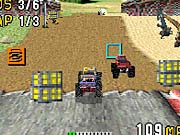More and more, racing games on the Game Boy Advance are coming to resemble racing games made for the original PlayStation. This observation isn't meant as an insult to the GBA's processor, but rather to highlight the fact that 3D hasn't historically been the system's strong suit, and that this trend is changing for the better, thanks to games like Drome Racers and THQ's latest, Monster Truck Madness. There are plenty of other racing games available for the GBA, but Monster Truck Madness is one of the most impressive ones yet. Too bad there's no link-up mode for multiplayer racing.

As the title suggests, the vehicles in Monster Truck Madness are the same modified big rigs, trucks, and vans you've come to know and love from the various monster truck competitions that travel from city to city, offering to sell you a full seat and promising that you'll only need the edge. Gargantuan rigs with names like "Grave Digger" and "Carolina Crusher" will ring a bell for anybody who's familiar with these events or the TV advertisements that promote them. A few of the events in Monster Truck Madness take place in the cramped, ramp-filled arenas that these weekly events are held in, but the majority of the game's 30 courses are set on fictitious circuits and back roads--all of which gobble up more than three minutes per single lap. The courses in this game are longer and have more twists and turns than what you typically see in other racing games, especially on handheld systems.
For the most part, the formula works really well. The handling and physics for each truck are skid-happy and bouncy, just as a monster truck fan would expect, and the presence of debris and weapon items on each track significantly raises the overall excitement level. You can plow through abandoned cars, crates, barricades, and other trash to activate a superfast rage state, or you can make contact with the various weapons to unleash them on the opponents behind you. In all, there are eight such items to activate, including turbo boosts, traction enhancers, and shrink rays. Monster Truck Madness is an arcade racing fan's dream, and it has all the necessary bells and whistles. The only noticeable weak point is that every weapon punishes only the vehicles behind you. There's no way to harm the race leaders unless you can drive fast enough to overtake them.
In all honesty, the GBA has no lack of racing games. What sets Monster Truck Madness apart from everything else is its graphics engine--a 3D marvel that draws each course using a combination of textured polygons and sprite-based objects. Simply put, developer Tantalus has taken what's been done on the Sony PlayStation since 1995 and accomplished the same thing on the Game Boy Advance. Each course has its own set of hills, twists, and curves, all of varying steepness and bank. The perspective is adjustable--there are two views behind the vehicle and one inside. As you drive through each course, you'll have to contend with the abandoned cars and trees that make up much of the scenery. When you drive over rocks and mud, your truck will accumulate body damage and dirt. The effect is purely cosmetic, but it's impressive nonetheless. The sense of speed is also rather remarkable, especially when you consider that up to seven other vehicles can be shown onscreen at any given moment. Unfortunately, the game does lose some points for the scenery bordering each course. These walls, for lack of a better term, are often more pixilated and less colorful than the roads, yards, and items they contain. Sometimes, you lose sight of where you're going because the vehicle blends into the outer fringes of the course.
Monster Truck Madness doesn't push the system's audio capabilities nearly as far as it does its visual capabilities. There are a dozen or so speech samples that pop up whenever you smash into something or overtake an opponent, but the brunt of the audio comes from the sound effects used for engines, skids, and crashes. Each of these audio effects sounds roughly the same, regardless of the vehicle you select, and the quality is about the same as in most other third-party racing games--generic and unrealistic. Despite this, the audio does fit well with what you see onscreen.

The real problem with Monster Truck Madness is that it's strictly a single-player experience. The three play modes--exhibition, race, and time trial--are sufficient for solo play, and the selection of 10 trucks and 30 courses is nothing to scoff at, but the absence of even a basic link mode is a glaring omission. The courses are so lengthy and the graphics are so impressive that you can't help but want to share the road with another human being. Besides, the CPU opponents tend to race each course in the same robotic manner, and they don't take advantage of power-up items in the same strategic fashion that a human opponent would. THQ's recent Drome Racers and Nintendo's classic Mario Kart: Super Circuit both have multiplayer link play, and now that there are more than 7 million GBA units in circulation, there's no good excuse for Monster Truck Madness not to.
If you're the kind of person who enjoys cathartic, arcade-style racing games, and you don't mind the absence of multiplayer play modes, you really should take a look at Monster Truck Madness.